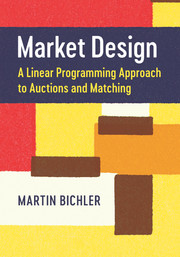1 - Introduction
Published online by Cambridge University Press: 08 December 2017
Summary
Market design is a kind of economic engineering, utilizing laboratory research, game theory, algorithms, simulations, and more. Its challenges inspire us to rethink longstanding fundamentals of economic theory.
Paul Milgrom, 2008The digital economy has led to many new services where supply is matched with demand for various types of goods and services. While only a few years ago academics were mainly concerned with models describing markets, more and more people and organizations are now in a position to design market rules that are being implemented in software. The design of markets is challenging as it is necessary to consider the strategic behavior of market participants, psychological and cognitive factors, and computational problems in order to implement the objectives of a designer. Market models in economics have not lost their importance, but recent years have led to many new insights and principles for the design of markets which are beyond traditional economic theory. In this book, we study market design, an engineering field at the intersection of computer science, economics, information systems, and operations research concerned with the design of real-world markets.
Consider a transportation market with multiple lanes on a transportation network, one shipper and multiple carriers. The shipper has a set of truckloads to be shipped from different origins to various destinations. The carriers are available to meet the transportation demand, and they are invited by the shipper to submit sealed bids. Carriers typically have preferences for bundles of lanes on a route such that there are no empty lanes without a shipment, and they also submit respective bids on packages of lanes. This simple logistics procurement example leads to challenges for the shipper.
First, the shipper needs to determine an optimal allocation of bundle bids such that his costs are minimized. Cost minimization is a computationally hard optimization problem in this setting. Second, carriers want to maximize their payoff and it is not necessarily in their interest to reveal their costs truthfully. They might charge a high markup on some lanes where they expect no competition or they might not bid on other lanes where they expect high competition. However, strategic manipulation of this sort can lead to suboptimal allocations of lanes to carriers, high procurement costs for the shipper, and high bid preparation costs for the carriers, who would benefit from information about their competitors.
- Type
- Chapter
- Information
- Market DesignA Linear Programming Approach to Auctions and Matching, pp. 1 - 8Publisher: Cambridge University PressPrint publication year: 2017



